Thailand Venomous Snake Photos
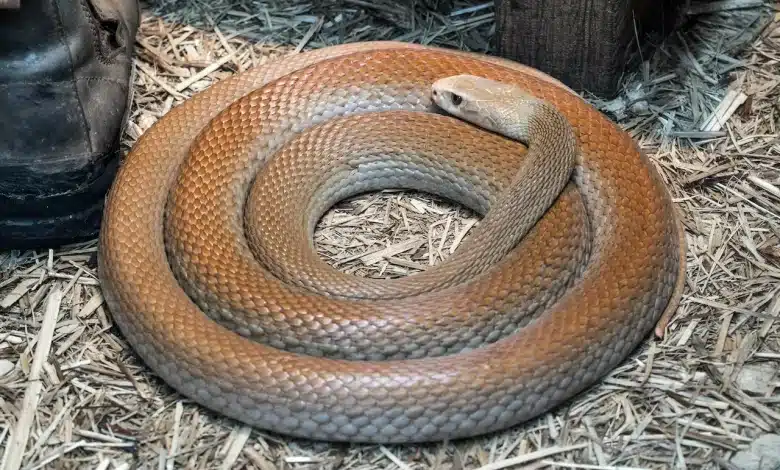
[Page Updated: 14 July 2023]
COBRA SNAKE PHOTOS
King Cobra (Ophiophagus hannah)
This is the longest venomous snake on the planet, and they get to around 6 meters long (19 feet!). The King Cobra length isn’t the scary part, it’s the amount of venom they can inject with one bite – which can kill an elephant. The brother of a friend I have was killed by a bite to the chest while doing a snake show with a king cobra. He died in less than 10 minutes. Kings are rather slow to bite, but if you are within striking distance, and they think you are a threat, they might feel threatened enough to strike.
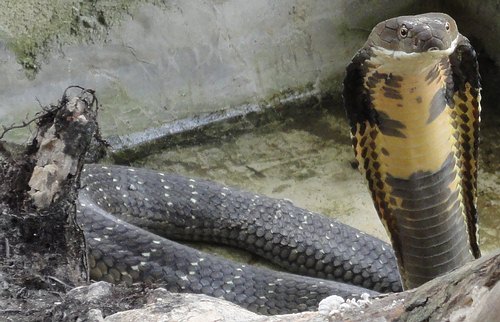
Monocled Cobras (Naja kaouthia)
These are usually quite dark brown, black, or dark grey snakes that are very fast strikers and movers. The Monocled Cobra’s venom is much more lethal than the King Cobra’s venom, so only a very small amount is needed to cause death in humans.
I met a woman who lost a husband recently, due to a bite on the man’s toe when it came out from under an outdoor refrigerator as he opened it to get a beer. The venom is both necrotic and neurotoxic. First, the man who was bitten lost his foot to necrosis. Then up to his knee. Then his entire leg and the doctor assured him and his family – he would be fine now.
He died days later. Monocled cobras are quicker to bite than king cobras and are exceptionally dangerous. Do not mess with this snake.
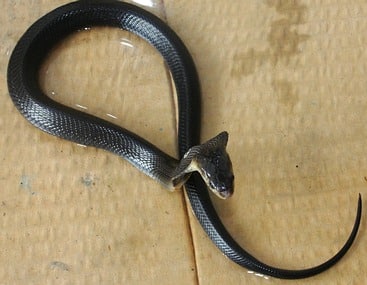
Naja kaouthia just might be my favorite snake… Monocled Cobra.
KRAIT SNAKE PHOTOS
Banded Kraits (Bungarus fasciatus)
Banded Kraits are yellow and black snakes that are active at night. During the day they are usually quite docile. Some are foolish enough to handhold them during the daylight hours. Show this snake more respect, its venom is quite lethal and kills people each year in Thailand and other countries in Southeast Asia.
Bands can be yellow and black, white and black, or even with longitudinal (yellow and black striped) instead of banding due to genetic anomaly.
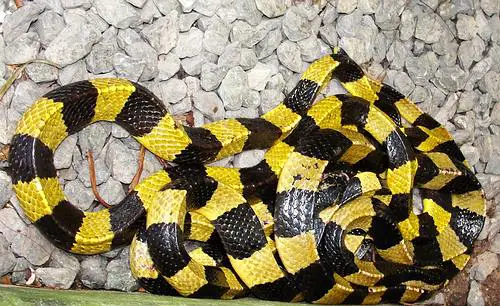
Venomous Snakebites and Near Misses!
More than 34 stories of venomous snakebites and very near misses from Southeast Asia’s most deadly snakes – King Cobra, Malayan Pit Viper, Monocled Cobra, Banded Krait, Malayan Krait, and more! Digital Book with over 100 pages by Vern Lovic.
Kraits
Malayan Kraits (Blue Krait) (Bungarus candidus)
Stronger venom than the Banded Krait, but not as lethal as it’s sister – the Multi-banded Krait, that looks very similar. Malayan Kraits are generally not interested in biting, but they have one of the most toxic venoms of any snake. Extreme caution is recommended.
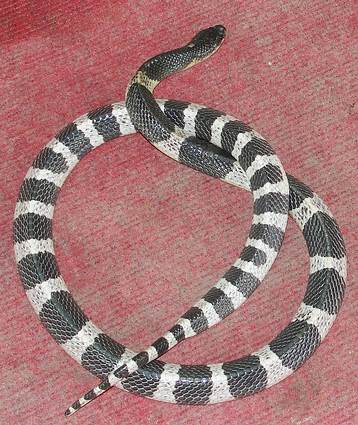
Red-headed Kraits (Bungarus flaviceps)
The Red-headed Krait, is seen as often during the day as at night. These ultra-lethal venomous snakes are quite rare to find at all. I have seen just two in more than a decade of looking for snakes in Thailand. Most people never see one in the wild. Their venom and behavior has not been well-studied but their venom is very toxic, like the other kraits.
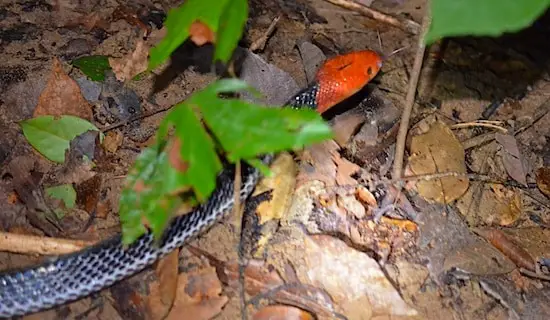
Thailand Snakes – Venomous and Non-Venomous snake information!
Many-banded Kraits (Bungarus multicinctus)
A small, less than 10-inch snake called Bungarus multicinctus killed famous American herpetologist, Joe Slowinski while he was on an expedition in Burma and far from a hospital with respirators. He died within 30 hours from the Many-banded Krait bite. These snakes have venom which is in the top 5 of the most lethal territorial snakes in the world. These snakes look very similar to the Malayan Krait, but they have more bands.
HAVE YOU READ THIS SNAKE BOOK YET? HIGHLY RECOMMENDED!
One of Top Snake Biologists in the World is in Burma and is Bitten by a Krait… Great Story!
VIPER SNAKE PHOTOS
Malayan Pit Vipers (Calloselasma rhodostoma)
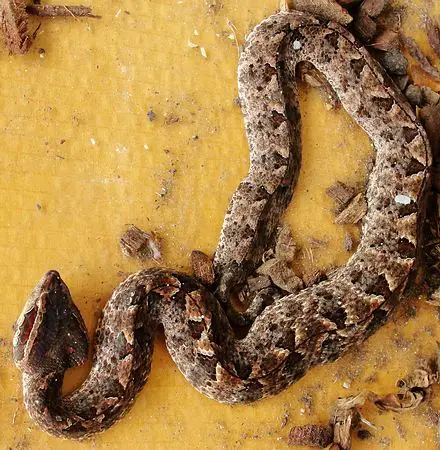
These snakes have the distinction of killing the most people across Thailand of any other snake. Malayan Pit Vipers have large heads, very large fangs, and a strong bite that can inflict deep wounds filled with venom. These snakes love the grass and light cover. They tend not to move at all when approached, and don’t give any noise before striking. Usually people die when they don’t get hospital treatment quickly. The venom is primarily hemotoxic and the victim bleeds from orifices on the body – as well as from the brain.
Siamese Viper (Daboia siamensis)
Found north, west and east of Bangkok – this snake is not to be found in southern Thailand. Siamese Vipers kill more people across the globe than any other. Like the Malayan pit viper these vipers are very strong, thick, and have large fangs.
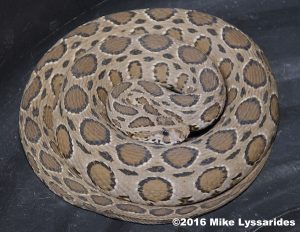
Brown-spotted Pit Viper (Trimeresurus venustus)
And she is a beautiful snake too! In the header of this website is a photo of what I think is the first venomous snake I saw in Thailand – the Trimeresurus venustus, the Beautiful Pit Viper. These are small vipers with very small scales – especially on the head. They are not so deadly, but you will have strong local reaction to the venom.
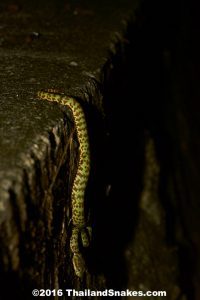
Beautiful Pit Viper – Trimeresurus venustus. Stunning in person.
The image I use in my header at the top of this page is also the T. venustus – Beautiful pit viper.
Kanburi Pit Viper (Trimeresurus kanburiensis)
Very rare and found only in and next to the Kanburi province of Thailand. Very similar in appearance to the beautiful viper.
Wagler’s Pit Viper (Tropidolaemus wagleri)
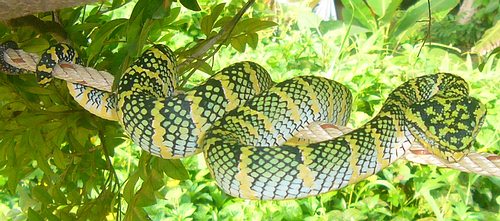
Wagler’s Pit Vipers are common in Phuket, and called by some, “The Temple Viper.” These are incredibly stunning snakes to look at. Their patterns are diverse. The photo above is a female. The male is about 1/4 the thickness, with a green overall color and red/white spots.
Hagen’s Bamboo Pit Viper – coming soon.
Pope’s Bamboo Pit Viper
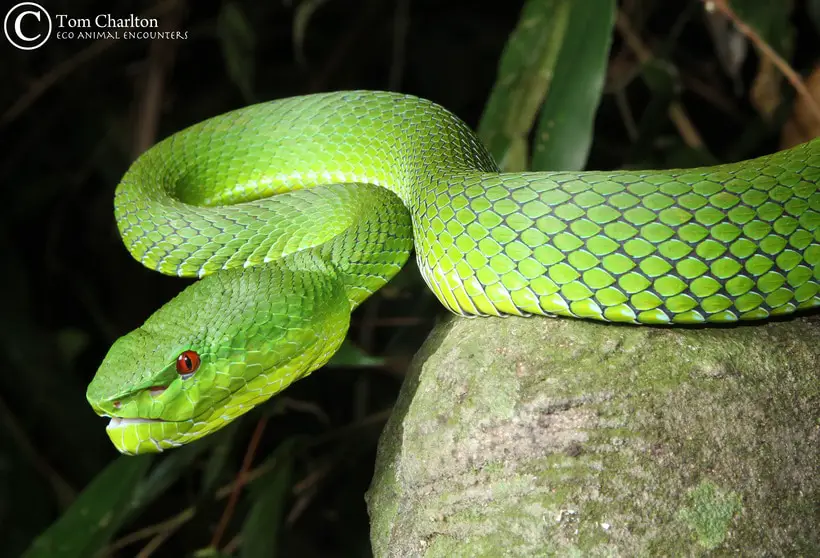
Wirot’s Palm Viper
Sorry, no image could be found.
Indo-Malayan Mountain Pit Viper
A father sent me photos of a snake that his young son was kicking at while they visited a waterfall on the Thai-Burma border in Phang Nga province. These are rare in Thailand, and have a nasty bite. Luckily, his son was not harmed.
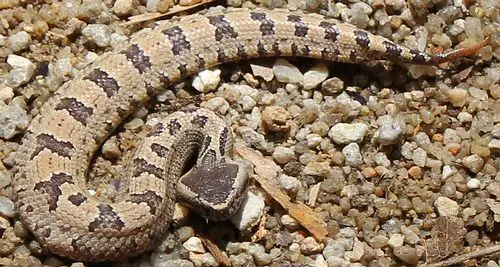
Mangrove Pit Viper (Trimeresurus purpureomaculatus)
These are pretty elusive. They spend time in mangrove areas near the ocean, and I’ve yet to see one in the wild. They are big biters and not docile at all. Be careful if you come across one of these small vipers. Mangrove Pit Vipers are beautiful – but dangerous.
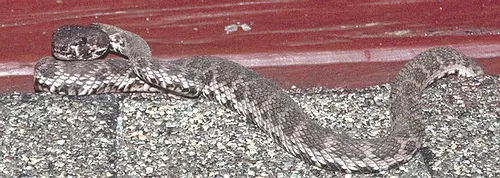
Large-eyed Green Pit Viper (Trimerusurus macrops)
As the name implies, the eyes are large on this green pit viper. Green pit vipers in Thailand are quite difficult to tell apart from each other. Be careful with all of them.
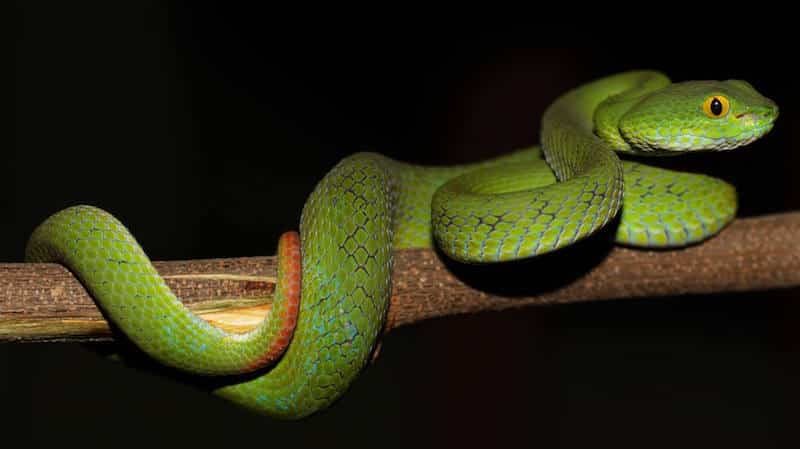
White-lipped Pit Viper (Trimeresurus albolabris)
Very dangerous and hard to identify. A very beautiful pit viper as the pictures show.
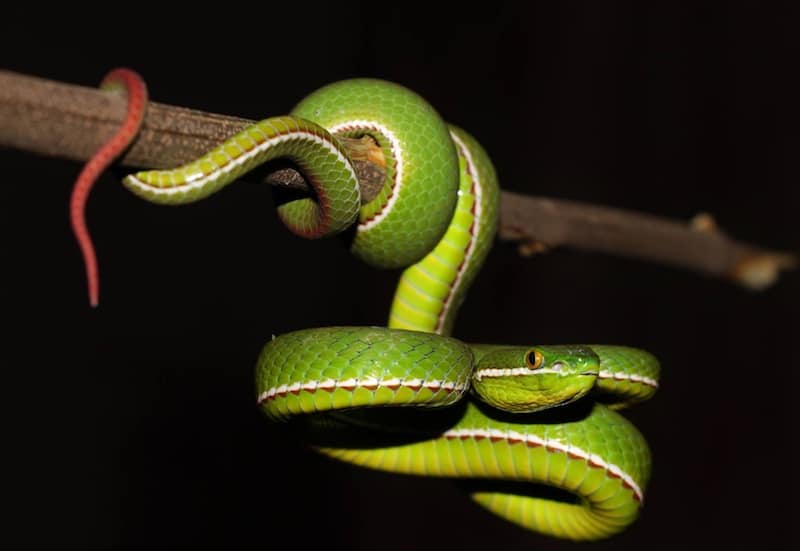
CORAL SNAKES PICTURES
Blue Malaysian Coral Snake (Calliophis bivirgata)
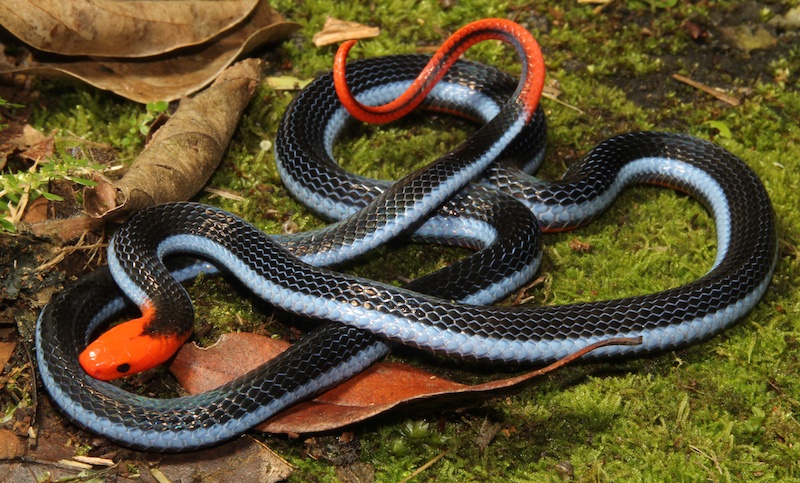
Small Spotted Coral Snake (Calliophis maculiceps)
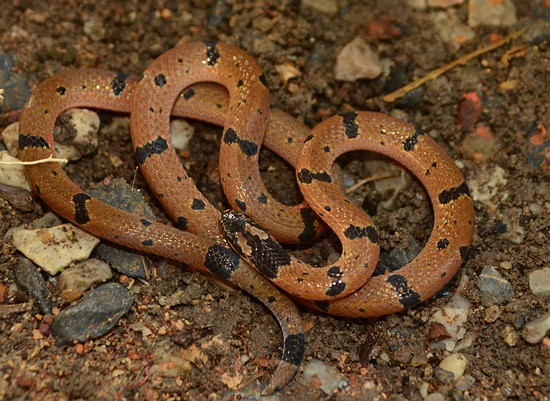
Venomous Snakebites and Near Misses!
More than 34 stories of venomous snakebite and very near misses from Southeast Asia’s most deadly snakes – King Cobra, Malayan Pit Viper, Monocled Cobra, Banded Krait, Malayan Krait, and more! Digital Book with over 100 pages by Vern Lovic.
Get your copy here >

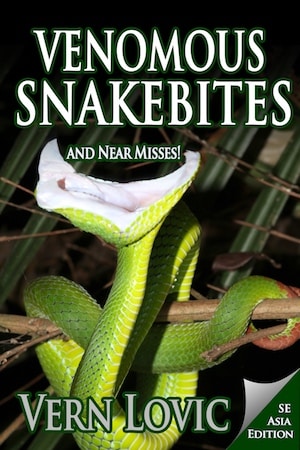
I live in Surin with my wife, daughter & mother in law. My wife spotted a slender green snake with some red markings behind its mouth on top of the open window frame outside, when l got closer to have a better look it leaped off into the grass & disappeared. We thought it might be a green cat eye snake but not sure, any knowledge on this snake would be appreciated
Green Cat-eyed snakes (Boiga cyanea) don’t have any red. It was likely, from its behavior, a Paradise Tree Snake possibly… Chrysopelea paradisi. Here’s a page for that one – https://thailandsnakes.com/venomous/rear-fanged/paradise-tree-snake-chrysopelea-paradisii-venomous-not-dangerous/
Is that it?
hi,
we just had a black and white crait near our pig pens, i just shood it off, but did make me jump in the torch light
great site by the way i use it all the time
Yep, they are hard to miss – and yeah, can make you jump too. Where are you at – which province?
Hi, we are going to visit Umphang in Tak province very near the Myanmar border and will be visiting jungle villages.
Can you advise us on which snakes live in this area please .
What other creatures may harm us may there be scorpions as well as mosquitos.
Many thanks
Mosquitos are by far the greatest threat. However, they have tigers and elephants, I believe. Snakes – cobras, pythons, vipers, kraits. Don’t walk at night without strong lights so you can watch every step. Stay alert… not sure what else to say.
Iyellow snake with black dots maybe 80 cm long in the swimming pool roof garden in soi 28 sukhumvit central bkk. How she got up here is the mistery!
Maybe the Chrysopelea ornata – Golden Tree Snake. Our INFO PAGE is here on that snake. Cheers!
are any of these snakes prone to be active in very hot weather during the mid day? I have been building ( clearing some trail for mtn bike usage) in Chaing rai area during the day, raking dead leaves down to dirt for a path and cutting bamboo shoots and chopping/hacking vines. Have been out the past four days in a secluded area, and seen ZERO snakes after moving hundreds of bamboo shoots on the ground and clearing a trail two to three feet wide completely down to dirt for more than 800 meters. I’m wearing some pretty thick boots with carhart/ type jeans. Got any suggestions on how to snakeproof myself more thoroughly or what specific snakes I can run into while raking thru the forest and moving bamboo? Perhaps I”m very stupid, just let me know. I can take constructive criticism.
To me, it seems so hot that I question if they would be active or found under shallow leaves as its still so hot with less than two inches of leaves covering the forest floor. What do you think? Bill Email: mtnguides2003@yahoo.com
Hi Bill, great comment – thanks for that. I know the monocled and spitting cobras are VERY active in the heat of the day. They ramp it up as they get hotter. In fact, I see monocled cobras here in Krabi at 3 pm. usually because it’s the hottest part of the day. Vipers are active at night, but sure, the Malayan Pit Viper could sit under some leaves in the heat. With boots – you’ll most likely be fine. The malayan pit vipers don’t strike above the knee – ever (from the ground). Cobras, you can usually see because they give notice – with the hooding and hissing. Cheers man – hope that helps.
Dear sir – I stumbled on this page and struck by your kindness to answer each question. You seem very well educated and providing such a good service. I just wanted to say thank you for the interesting reading and what you’re doing for your readers.
By the way, I live in Minneapolis, Minnesota and recently met a woman from Thailand. I am breaking up with her immediately. Ha ha.
Hi Kevin, you’re welcome. ha! poor lady…